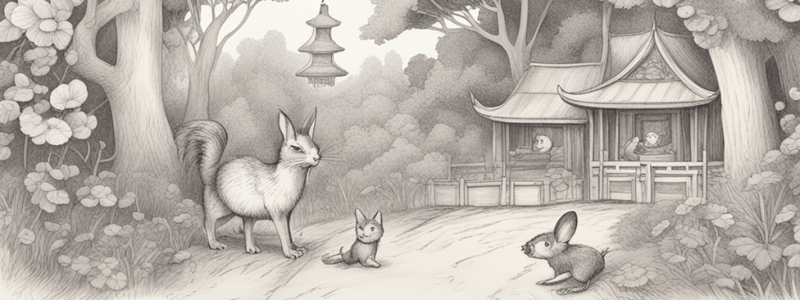Podcast
Questions and Answers
中国古代的哪项发明在105年左右彻底改变了亚洲甚至欧洲的通讯和知识保存方式?
中国古代的哪项发明在105年左右彻底改变了亚洲甚至欧洲的通讯和知识保存方式?
- 稻农业
- 纸张 (correct)
- 铁冶金
- 丝绸的生产
中国历史上第一个建立中央集权帝国的朝代是哪一个?
中国历史上第一个建立中央集权帝国的朝代是哪一个?
- 汉朝
- 宋朝
- 唐朝
- 秦朝 (correct)
中国长城最初是为了应对哪些邻国的入侵而修建的?
中国长城最初是为了应对哪些邻国的入侵而修建的?
- 日本
- 印度
- 韩国
- 蒙古 (correct)
下列哪位人物领导了反对秦朝统治并建立了汉朝?
下列哪位人物领导了反对秦朝统治并建立了汉朝?
哪次战争标志着中国与西方国家建立了贸易关系,影响了中国经济的巨大变革?
哪次战争标志着中国与西方国家建立了贸易关系,影响了中国经济的巨大变革?
Flashcards are hidden until you start studying
Study Notes
Chinese History: A Journey through Time
When we delve into Chinese history, we find ourselves traversing a vast landscape of over 5,000 years filled with fascinating events, cultures, and people who have shaped this civilization's identity. This journey can be divided broadly into two distinct eras—Ancient China and Modern China.
Ancient China (before the Qin Dynasty)
Beginning around 2100 BCE, the earliest known records from ancient China were written using pictographic symbols called Oracle Bones. By 770 BCE, Confucius was born, and he became one of the most influential thinkers in all of human history. He articulated ideas such as filial piety, loyalty, and reciprocity which still influence many societies today. His teachings would later become enshrined in traditional Confucianism. During the Warring States period (403–221 BCE), philosophical thought exploded across China as seven schools of philosophy contended for dominance. One notable philosopher during this time was Laozi, who developed Taoist principles that emphasized living simply and harmoniously with nature.
In the mid-third century BCE, China was unified under Emperor Yu and three kingdoms emerged after his death in 221 BCE. These rival kingdoms fought each other until 202 BCE when they agreed to create a united empire ruled by Han dynasties. It is also important to note the invention of paper in ancient China around 105 CE, which revolutionized communication and knowledge preservation throughout Asia and eventually Europe too. Other significant developments included the invention and spread of rice agriculture, silk production, and iron metallurgy.
Modern China (Qin Dynasty to Present Day)
The Qin Dynasty, beginning around 221 BCE, established the first centralized imperial state in China. However, its rule ended abruptly due to widespread rebellion led by Liu Bang, who started the Han Dynasty. The Great Wall of China was built during this era, marking a key point in China's military defenses against invasions from neighboring countries like Mongolia. Under the Ming Dynasty (1368-1644 AD), China began trade relations with the West, including Portugal, transforming its economy significantly. In more recent times, China has seen major political upheavals such as the Opium Wars (the First Sino-British War, lasting between 1839-42, and Second Sino-Japanese War, 1856-60). After World War II, the People's Republic of China was formed, followed by Mao Zedong's reign of terror resulting in millions of deaths. Since then, modernization efforts stemming back to the Cultural Revolution continue apace today.
In conclusion, understanding Chinese history necessitates a deep dive into various periods spanning thousands of years. From its early days marked by philosophical thought and agricultural advancements to the rise of empires, wars, and economic development; from cultural revolutions to present day politics – it's been quite a ride!
Studying That Suits You
Use AI to generate personalized quizzes and flashcards to suit your learning preferences.




